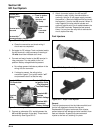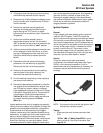
5B.12
Section 5B
EFI Fuel System
1. Oxygen sensor must be hot (minimum of 400°C,
725°F). Run engine for about 5 minutes. With the
engine running, disconnect the oxygen sensor
lead from the wiring harness. Set VOA meter for
DC volts and connect the red lead to the
disconnected sensor lead, and the black lead to
the sensor shell. Check for a voltage reading
between 0.2 v-1.0 v.
a. If voltage is in the specified range, go to Step 2.
b. If the voltage is not in the specified range,
reconnect the oxygen sensor lead. With the
lead connected, probe or connect the sensor
connection with the red VOA meter lead.
Attach the black VOA meter lead to a known
good ground location. Start and run the engine
at 3/4 throttle and note the voltage output.
The reading should cycle between 0.2 v-1.0 v,
which indicates the oxygen sensor is
functioning normally and also the fuel delivery
controlled by the ECU is within prescribed
parameters. If the voltage readings show a
steady decline, bump the governor lever to
make the engine accelerate very quickly and
check the reading again. If voltage momentarily
increases and then again declines, without
cycling, engine may be running lean due to
incorrect TPS initialization. Shut off the engine,
perform TPS initialization, and then repeat the
test. If TPS initialization cannot be achieved,
perform step c.
c. Replace the oxygen sensor (page 5B.13).
Run the engine long enough to bring the new
sensor up to temperature and repeat the output
test from step 1. The cycling voltage from 0.2
to 1.0 volt should be indicated.
2. Move the black voltmeter lead to the engine
ground location and repeat the output test. The
same voltage (0.2 v-1.0 v) should be indicated.
a. If the same voltage reading exists, go on to
Step 3.
b. If the voltage output is no longer correct, a bad
ground path exists between the sensor and the
engine ground. Touch the black lead at various
points, backtracking from the engine ground
back toward the sensor, watching for a voltage
change at each location. If the correct voltage
reading reappears at some point, check for a
problem (rust, corrosion, loose joint or
connection) between that point and the previous
checkpoint. For example, if the reading is too low
at points on the crankcase, but correct voltage is
indicated when the black lead is touched to the
skin of the muffler, the flange joints at the exhaust
ports become suspect.
3. With sensor still hot (minimum of 400°C, 752°F),
switch meter to the Rx1K or Rx2K scale and
check the resistance between the sensor lead
and sensor case. It should be less than 2.0 K
ΩΩ
ΩΩ
Ω.
a. If the resistance is less than 2.0 K
ΩΩ
ΩΩ
Ω, go to
Step 4.
b. If the resistance is greater than 2.0 K
ΩΩ
ΩΩ
Ω, the
oxygen sensor is bad, replace it.
4. Allow the sensor to cool (less than 60°C, 140°F)
and retest the resistance with the meter set on the
Rx1M scale. With sensor cool, the resistance
should be greater than 1.0 M
ΩΩ
ΩΩ
Ω.
a. If the resistance is greater than 1.0 M
ΩΩ
ΩΩ
Ω, go to
Step 5.
b. If the resistance is less than 1.0 M
ΩΩ
ΩΩ
Ω, the
sensor is bad, replace it.
5. With the oxygen sensor disconnected and engine
not running, disconnect the main harness
connector from the ECU and set the meter to the
Rx1 scale. Check the circuit continuity as follows:
“35 Pin” (MA 1.7) Metal-Cased ECU: Check for
continuity from pin #9 of the ECU connector (see
page 5B.28) to the shell of the oxygen sensor,
and from pin #10 to the sensor connector terminal
of the main harness. Both tests should indicate
continuity.
“24 Pin” (MSE 1.0) Plastic-Cased ECU: Check
for continuity from pin #15 of the ECU connector
(see page 5B.31) to the shell of the oxygen
sensor, and from pin #11 to the sensor connector
terminal of the main harness. Both tests should
indicate continuity.
“32 Pin” (MSE 1.1) Plastic Cased ECU: Check
for continuity from pin #19 of the ECU connector
(see page 5B.32) to the shell of the oxygen
sensor, and from pin #20 to the sensor terminal of
the main harness. Both tests should indicate
continuity.


















